
Paulinus of Nola born Pontius Meropius Anicius Paulinus, was a Roman poet, writer, and senator who attained the ranks of suffect consul and governor of Campania but – following the assassination of the emperor Gratian and under the influence of his Hispanic wife Therasia of Nola — abandoned his career, was baptized as a Christian, and probably after Therasia's death became bishop of Nola in Campania. While there, he wrote poems in honor of his predecessor Saint Felix and corresponded with other Christian leaders throughout the empire. He is credited with the introduction of bells to Christian worship and helped resolve the disputed election of Pope Boniface I.

The Basilica of Saint-Denis is a large former medieval abbey church and present cathedral in the commune of Saint-Denis, a northern suburb of Paris. The building is of singular importance historically and architecturally as its choir, completed in 1144, is widely considered the first structure to employ all of the elements of Gothic architecture.

A crypt is a stone chamber beneath the floor of a church or other building. It typically contains coffins, sarcophagi, or religious relics.
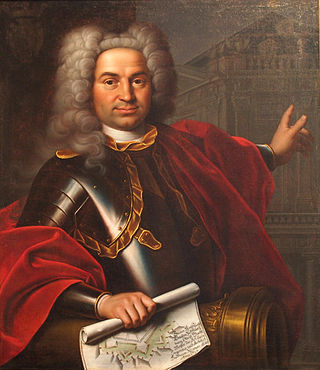
Johann Balthasar Neumann, usually known as Balthasar Neumann, was a German architect and military artillery engineer who developed a refined brand of Baroque architecture, fusing Austrian, Bohemian, Italian, and French elements to design some of the most impressive buildings of the period, including the Würzburg Residence and the Basilica of the Fourteen Holy Helpers.

Saint-Maximin-la-Sainte-Baume is a commune in the southeastern French department of Var, in the Provence-Alpes-Côte d'Azur region. Located 40 km (25 mi) east of Aix-en-Provence, the town lies at the foot of the Sainte-Baume mountains. Baume or bama is the Provençal equivalent of cave. The town's basilica is dedicated to Mary Magdalene.
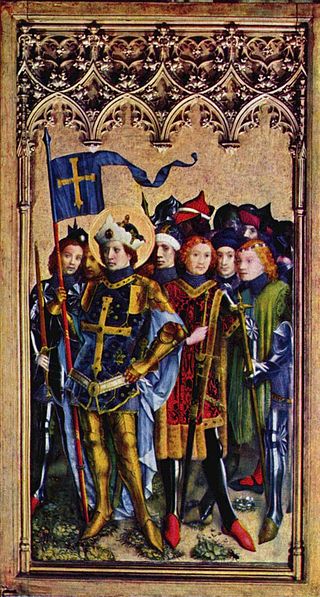
The Theban Legion figures in Christian hagiography as a Roman legion from Egypt —"six thousand six hundred and sixty-six men" — consisting of Christian soldiers who were martyred together in 286, according to the hagiographies of Maurice, the chief among the Legion's saints. Their feast day is held on September 22.
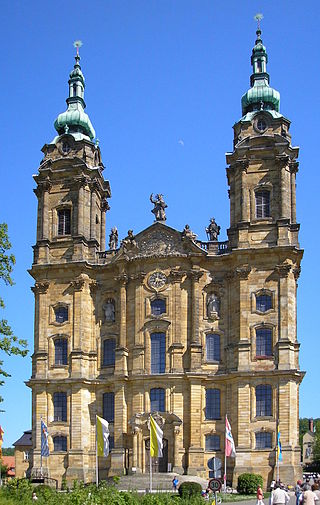
The Basilica of the Fourteen Holy Helpers is a church located near the town of Bad Staffelstein near Bamberg, in Bavaria, southern Germany. The late Baroque-Rococo basilica, designed by Balthasar Neumann, was constructed between 1743 and 1772. It is dedicated to the Fourteen Holy Helpers, a group of saints venerated together in the Catholic Church, especially in Germany at the time of the Black Death. The interior has been nicknamed as "God's Ballroom"

Neresheim Abbey or the Abbey of Saints Ulrich and Afra, Neresheim is located above the town of Neresheim in Baden-Württemberg, southern Germany. It is now a Benedictine monastery and is part of the Beuronese Congregation.
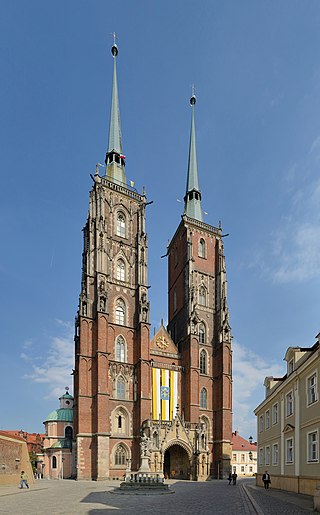
The Cathedral of St. John the Baptist in Wrocław is the seat of the Roman Catholic Archdiocese of Wrocław and a landmark of the city of Wrocław in Poland. The cathedral, located in the Ostrów Tumski district, is a Gothic church with Neo-Gothic additions. The current standing cathedral is the fourth church to have been built on the site.

The Church of Saint Demetrius, or Hagios Demetrios, is the main sanctuary dedicated to Saint Demetrius, the patron saint of Thessaloniki, dating from a time when it was the second largest city of the Byzantine Empire. Since 1988, it has been on the UNESCO World Heritage List as a part of the site Paleochristian and Byzantine monuments of Thessaloniki.
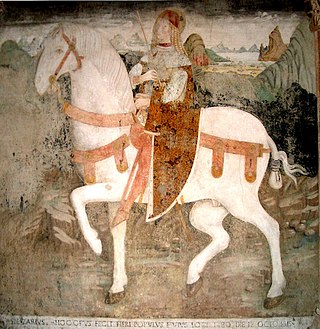
Nazarius and Celsus (Italian: San Nazaro e San Celso; German: Nazarius were two martyrs of whom little is known beyond the discovery of their bodies by Ambrose of Milan.
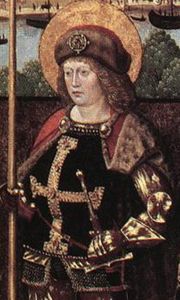
Gereon of Cologne, who may have been a soldier, was martyred at Cologne by beheading, probably in the early 4th century.

Christoph Thomas Scheffler was a German painter of the rococo period. He is best known for his frescoes.

Bonn Minster is a Roman Catholic church in Bonn. It is one of Germany's oldest churches, having been built between the 11th and 13th centuries. At one point the church served as the de facto cathedral for the Archbishopric of Cologne, because it is the major church of what was then the Archbishop-Elector's residence. It is now a minor basilica. It served as the inspiration for the Kaiser Wilhelm Memorial Church in Berlin, as Kaiser Wilhelm II had studied in Bonn.
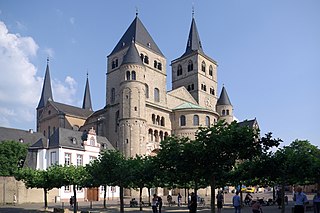
The High Cathedral of Saint Peter in Trier, or Trier Cathedral, is a Roman Catholic cathedral in Trier, Rhineland-Palatinate, Germany. It is the oldest church in Germany and the largest religious structure in Trier, notable for its long life span and grand design. The central part of the nave was built of Roman brick in the early fourth century, resulting in a cathedral that was added onto gradually in different eras. The imposing Romanesque westwork, with four towers and an additional apse, has been copied repeatedly. The Trier Cathedral Treasury contains an important collection of Christian art. In 1986 the church was listed as a UNESCO World Heritage Site, as part of the Roman Monuments, Cathedral of St. Peter and Church of Our Lady in Trier.

Xanten Cathedral, sometimes called St. Victor's Cathedral, is a Catholic church situated in Xanten, a historic town in the lower Rhine area, North Rhine-Westphalia, Germany. It is considered the biggest cathedral between Cologne and the sea. In 1936 it was declared a minor basilica by Pope Pius XI. Even though the church is called a cathedral, it has never been the seat of a bishop.

Maurice was an Egyptian military leader who headed the legendary Theban Legion of Rome in the 3rd century, and is one of the favourite and most widely venerated saints of that martyred group. He is the patron saint of several professions, locales, and kingdoms.

The Basilica of St. Castor is the oldest church in Koblenz in the German state of Rhineland Palatinate. It is located near Deutsches Eck at the confluence of the Rhine and the Moselle. A fountain called Kastorbrunnen was built in front of the basilica during Napoleon's invasion of Russia in 1812. Pope John Paul II raised St. Castor to a basilica minor on 30 July 1991. This church is worth seeing for the historical events that have occurred in it, its extensive Romanesque construction and its largely traditional furnishings.
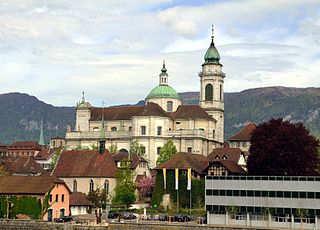
The St. Ursus Cathedral or Solothurn Cathedral is the cathedral of the Roman Catholic Diocese of Basel in the city of Solothurn, Switzerland. It is a Swiss heritage site of national significance.

Maria Magdalena Merten was a German professed religious from the Ursulines. Merten worked as a teacher from 1902 to 1908 in the secular environment while then serving as a teacher while in the religious life from her profession until 1916 when ill health forced her to stop teaching.























